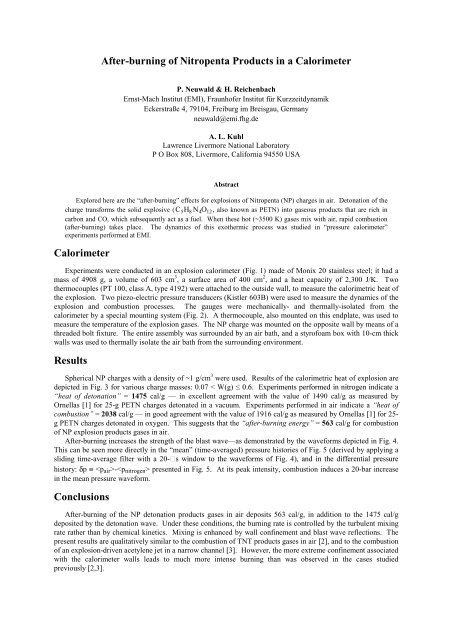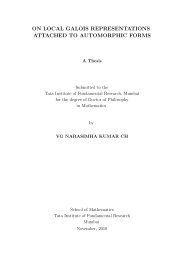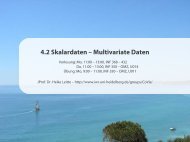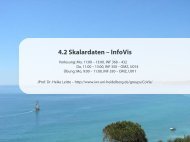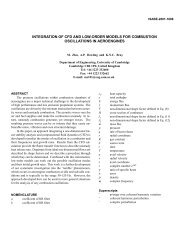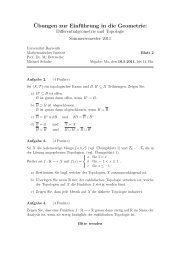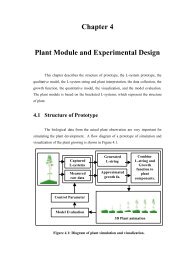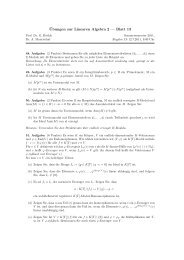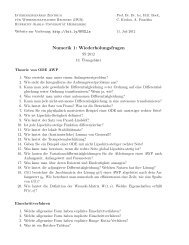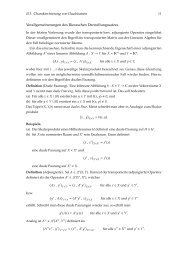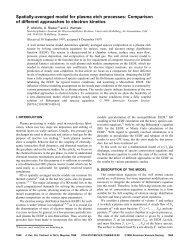After-burning of Nitropenta Products in a Calorimeter ... - IWR
After-burning of Nitropenta Products in a Calorimeter ... - IWR
After-burning of Nitropenta Products in a Calorimeter ... - IWR
Create successful ePaper yourself
Turn your PDF publications into a flip-book with our unique Google optimized e-Paper software.
<strong>After</strong>-<strong>burn<strong>in</strong>g</strong> <strong>of</strong> <strong>Nitropenta</strong> <strong>Products</strong> <strong>in</strong> a <strong>Calorimeter</strong><br />
P. Neuwald & H. Reichenbach<br />
Ernst-Mach Institut (EMI), Fraunh<strong>of</strong>er Institut für Kurzzeitdynamik<br />
Eckerstraße 4, 79104, Freiburg im Breisgau, Germany<br />
neuwald@emi.fhg.de<br />
A. L. Kuhl<br />
Lawrence Livermore National Laboratory<br />
P O Box 808, Livermore, California 94550 USA<br />
Abstract<br />
Explored here are the “after-<strong>burn<strong>in</strong>g</strong>” effects for explosions <strong>of</strong> <strong>Nitropenta</strong> (NP) charges <strong>in</strong> air. Detonation <strong>of</strong> the<br />
charge transforms the solid explosive ( C 5H 8 N 4 O 12 , also known as PETN) <strong>in</strong>to gaseous products that are rich <strong>in</strong><br />
carbon and CO, which subsequently act as a fuel. When these hot (~3500 K) gases mix with air, rapid combustion<br />
(after-<strong>burn<strong>in</strong>g</strong>) takes place. The dynamics <strong>of</strong> this exothermic process was studied <strong>in</strong> “pressure calorimeter”<br />
experiments performed at EMI.<br />
<strong>Calorimeter</strong><br />
Experiments were conducted <strong>in</strong> an explosion calorimeter (Fig. 1) made <strong>of</strong> Monix 20 sta<strong>in</strong>less steel; it had a<br />
mass <strong>of</strong> 4908 g, a volume <strong>of</strong> 603 cm 3 , a surface area <strong>of</strong> 400 cm 2 , and a heat capacity <strong>of</strong> 2,300 J/K. Two<br />
thermocouples (PT 100, class A, type 4192) were attached to the outside wall, to measure the calorimetric heat <strong>of</strong><br />
the explosion. Two piezo-electric pressure transducers (Kistler 603B) were used to measure the dynamics <strong>of</strong> the<br />
explosion and combustion processes. The gauges were mechanically- and thermally-isolated from the<br />
calorimeter by a special mount<strong>in</strong>g system (Fig. 2). A thermocouple, also mounted on this endplate, was used to<br />
measure the temperature <strong>of</strong> the explosion gases. The NP charge was mounted on the opposite wall by means <strong>of</strong> a<br />
threaded bolt fixture. The entire assembly was surrounded by an air bath, and a styr<strong>of</strong>oam box with 10-cm thick<br />
walls was used to thermally isolate the air bath from the surround<strong>in</strong>g environment.<br />
Results<br />
Spherical NP charges with a density <strong>of</strong> ~1 g/cm 3 were used. Results <strong>of</strong> the calorimetric heat <strong>of</strong> explosion are<br />
depicted <strong>in</strong> Fig. 3 for various charge masses: 0.07 < W(g) ”([SHULPHQWVSHUIRUPHGLQQLWURJHQLQGLFDWHD<br />
“heat <strong>of</strong> detonation” = 1475 cal/g — <strong>in</strong> excellent agreement with the value <strong>of</strong> 1490 cal/g as measured by<br />
Ornellas [1] for 25-g PETN charges detonated <strong>in</strong> a vacuum. Experiments performed <strong>in</strong> air <strong>in</strong>dicate a “heat <strong>of</strong><br />
combustion” = 2038 cal/g — <strong>in</strong> good agreement with the value <strong>of</strong> 1916 cal/g as measured by Ornellas [1] for 25-<br />
g PETN charges detonated <strong>in</strong> oxygen. This suggests that the “after-<strong>burn<strong>in</strong>g</strong> energy” = 563 cal/g for combustion<br />
<strong>of</strong> NP explosion products gases <strong>in</strong> air.<br />
<strong>After</strong>-<strong>burn<strong>in</strong>g</strong> <strong>in</strong>creases the strength <strong>of</strong> the blast wave—as demonstrated by the waveforms depicted <strong>in</strong> Fig. 4.<br />
This can be seen more directly <strong>in</strong> the “mean” (time-averaged) pressure histories <strong>of</strong> Fig. 5 (derived by apply<strong>in</strong>g a<br />
slid<strong>in</strong>g time-average filter with a 20- V ZLQGRZ WR WKH ZDYHIRUPV RI )LJ DQG LQ WKH GLIIHUHQWLDO SUHVVXUH<br />
history: δp ≡ - presented <strong>in</strong> Fig. 5. At its peak <strong>in</strong>tensity, combustion <strong>in</strong>duces a 20-bar <strong>in</strong>crease<br />
<strong>in</strong> the mean pressure waveform.<br />
Conclusions<br />
<strong>After</strong>-<strong>burn<strong>in</strong>g</strong> <strong>of</strong> the NP detonation products gases <strong>in</strong> air deposits 563 cal/g, <strong>in</strong> addition to the 1475 cal/g<br />
deposited by the detonation wave. Under these conditions, the <strong>burn<strong>in</strong>g</strong> rate is controlled by the turbulent mix<strong>in</strong>g<br />
rate rather than by chemical k<strong>in</strong>etics. Mix<strong>in</strong>g is enhanced by wall conf<strong>in</strong>ement and blast wave reflections. The<br />
present results are qualitatively similar to the combustion <strong>of</strong> TNT products gases <strong>in</strong> air [2], and to the combustion<br />
<strong>of</strong> an explosion-driven acetylene jet <strong>in</strong> a narrow channel [3]. However, the more extreme conf<strong>in</strong>ement associated<br />
with the calorimeter walls leads to much more <strong>in</strong>tense <strong>burn<strong>in</strong>g</strong> than was observed <strong>in</strong> the cases studied<br />
previously [2,3].
References<br />
[1] Ornellas, D. L., Calorimetric Determ<strong>in</strong>ation <strong>of</strong> the Heat and <strong>Products</strong> <strong>of</strong> Detonation for Explosives: October<br />
1961 to April 1982, Lawrence Livermore National Laboratory, UCRL-52821, Livermore, CA, 1982.<br />
[2] Kuhl, A., L., Ferguson, R. E., Spektor, R., Oppenheim, A. K., “Combustion <strong>of</strong> TNT <strong>Products</strong> <strong>in</strong> a Conf<strong>in</strong>ed<br />
Explosion”, Book <strong>of</strong> Abstracts: 17 th -ICDERS, University <strong>of</strong> Heidelberg Press, 1999.<br />
[3] Kuhl, A. L., Ferguson, R. E., Reichenbach, H., Neuwald, P., and Oppenheim, A.K., “Dynamics <strong>of</strong> an<br />
Explosion-Driven Planar Exothermic Jet”, JSME Int. Journal—Series B, 41 (2), 1998, pp. 416-423.<br />
Figures<br />
Figure 1. Schematic <strong>of</strong> the 0.6-liter chamber used for “pressure calorimeter” experiments with spherical<br />
0.5 g <strong>Nitropenta</strong> charges (dimensions <strong>in</strong> mm). Shock-isolated pressure gauges and a<br />
thermocouple gauge were mounted on an end plate. The charge assembly was located on the<br />
opposite endplate. Two PT 100 thermocouples on the outside wall were used to measure the<br />
calorimetric heat <strong>of</strong> explosion.<br />
Figure 2. Schematic <strong>of</strong> the shock-isolated mount<strong>in</strong>g <strong>of</strong> the pressure gauges. The rubber tube decouples<br />
the gauge from acoustic waves <strong>in</strong> the calorimeter walls, the choke reduces peak pressures to<br />
avoid gauge overload and, <strong>in</strong> addition ; shields the gauge aga<strong>in</strong>st the hot product gases.
1500<br />
1000<br />
air<br />
∆H [cal]<br />
500<br />
nitrogen<br />
test 72 (<strong>in</strong> vacuum)<br />
0<br />
0.0 0.2 0.4 0.6 0.8<br />
W [g]<br />
Figure 3. Heat <strong>of</strong> explosion for spherical NP charges detonated <strong>in</strong> a 0.6-liter chamber:<br />
∆H = 2038 (cal/g) × W <strong>in</strong> 1-bar air, and ∆H = 1475 (cal/g) × W <strong>in</strong> 1-bar nitrogen.<br />
70<br />
60<br />
air<br />
50<br />
p [bar]<br />
40<br />
30<br />
20<br />
nitrogen<br />
10<br />
0<br />
-20 0 20 40 60 80 100<br />
t-TOA [µs]<br />
Figure 4. Pressure histories for spherical NP charges detonated <strong>in</strong> the 0.6-liter chamber <strong>in</strong> air and<br />
nitrogen atmospheres. Charge weight W=0.436 g (for air) or W=0.450 g (for nitrogen).
50<br />
air<br />
[bar]<br />
40<br />
30<br />
nitrogen<br />
20<br />
10<br />
0<br />
-20 0 20 40 60 80 100<br />
t-TOA [µs]<br />
Figure 5. Mean pressure histories for spherical NP charges detonated <strong>in</strong> the 0.6-liter chamber. Charge<br />
weight see Fig. 4.<br />
25<br />
20<br />
δp[bar]<br />
15<br />
10<br />
5<br />
0<br />
-20 0 20 40 60 80 100<br />
t-TOA [µs]<br />
Figure 6. Differential mean pressure history (<strong>in</strong>duced by after-<strong>burn<strong>in</strong>g</strong>) <strong>of</strong> 0.436-g NP charge <strong>in</strong> air.


